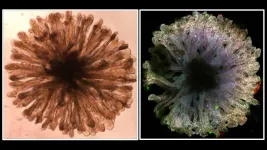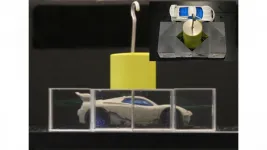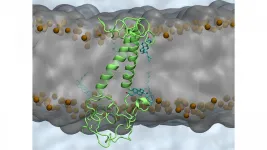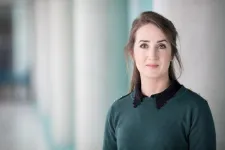Scientists discover unreported plant body part
2021-06-15
(Press-News.org) For many, the Thale cress (Arabidopsis thaliana) is little more than a roadside weed, but this plant has a long history with scientists trying to understand how plants grow and develop. Arabidopsis was first scientifically described as early as the 16th century and the first genetic mutant was identified in the 1800s. Since the 1940s, Arabidopsis has increased in popularity within the scientific community, which continues to use it as a model system to explore plant genetics, development and physiology to this day.
One might expect that after decades of scientific scrutiny the structure of Arabidopsis had been fully documented, but a new study from scientists from The Pennsylvania State University, USA, has revealed that this humble plant still has some surprises. The researchers describe a previously unreported structure called the 'cantil', which connects to the stem at one end and hangs in the air to hold up the flower-bearing stalk, similar to the function of a cantilever in structural engineering.
"I first observed the cantils in 2008," said Dr Timothy Gookin, a postdoctoral researcher working in the group of Professor Sarah Assmann. "I initially didn't trust any of the results; I thought it must be an artefact of genetic contamination, perhaps combined with environmental contamination of the water, soil, fertilizer or even the building air supply."
How have cantils eluded scientists for so long? First, cantils are rare; they only develop under certain conditions that cause the plant to delay flowering, such as short day lengths, and cantils only form at the precise point at which the plant begins to flower. In addition, as Dr Gookin discovered, some popular Arabidopsis strains have genetic mutations that make them incapable of producing cantils at all.
Nonetheless, Dr Gookin set about the gargantuan task of proving that cantils are a naturally occurring structure and not an artefact of mutation or contamination - an effort that took more than a decade. "It took over 12 years of experimentation to really get a grasp on what we were seeing and to understand how cantils were regulated. This study required the growth of 3,782 plants to full maturity and the manual inspection of over 20,000 flower-bearing stalks in 34 unique plant lines," explained Dr Gookin. "I finally deemed the cantils a natural phenomenon after identifying them in wild-type (non-mutant) plants from different sources, which were growing in independent locations and diverse conditions."
During his extensive research, Dr Gookin identified a number of mutant plants in which cantils appear more frequently, revealing some of the genetic factors that control cantil development. The discovery of cantils is not only a lesson in the virtues of perseverance, but their development also provides important clues for understanding the conditional growth of plant structures in response to their environment. "One speculative interpretation is that the cantil represents a highly repressed ancestral linkage between different types of flowering plant architectures; the multiple layers of genetic and environmental factors that regulate cantil development are certainly quite striking," said Dr Gookin.
INFORMATION:
ADDITIONAL INFORMATION: Timothy Gookin is a postdoctoral researcher, and Sarah Assmann is the Waller Professor of Biology at Pennsylvania State University. Timothy Gookin is the lead corresponding author of the article.
REFERENCE: Gookin, T. E. and Assmann, S. M. (2021). Cantil: a previously unreported organ in wild-type Arabidopsis regulated by FT, ERECTA and heterotrimeric G proteins. Development, 148, dev195545. doi:10.1242/dev.195545
If reporting this story, please mention Development as the source and, if reporting online, please carry a link to: https://journals.biologists.com/dev/article-lookup/DOI/10.1242/dev.195545
The story is COPYRIGHTED. Therefore advance permission is required before any and every reproduction of each article in full. PLEASE CONTACT permissions@biologists.com. The embargoed text of the article and embargoed multimedia are available to registered journalists at http://pr.biologists.com/. Unregistered journalists must register at http://pr.biologists.com/ to access the embargoed content.
[Attachments] See images for this press release:

ELSE PRESS RELEASES FROM THIS DATE:
2021-06-15
A team of scientists at the Keck School of Medicine of USC has created what could be a key building block for assembling a synthetic kidney. In a new study in Nature Communications, Zhongwei Li and his colleagues describe how they can generate rudimentary kidney structures, known as organoids, that resemble the collecting duct system that helps maintain the body's fluid and pH balance by concentrating and transporting urine.
"Our progress in creating new types of kidney organoids provides powerful tools for not only understanding development and disease, but also finding new treatments and regenerative approaches for patients," said Li, the study's corresponding ...
2021-06-15
What The Study Did: In this survey of 1,186 medical, graduate and health professional school faculty, more faculty considered leaving since the COVID-19 pandemic than before. Faculty with children, particularly female faculty with children, were more likely to consider leaving since the pandemic.
Authors: Susan A. Matulevicius, M.D., M.S.C.S., of the University of Texas Southwestern in Dallas, is the corresponding author.
To access the embargoed study: Visit our For The Media website at this link https://media.jamanetwork.com/
(doi:10.1001/jamanetworkopen.2021.13539)
Editor's Note: Please ...
2021-06-15
What The Study Did: Researchers examined whether a sweetened beverage tax in Philadelphia was associated with sustained changes in beverage prices and purchases of sweetened beverages and high-sugar foods two years after implementation of the tax.
Authors: Christina A. Roberto, Ph.D., of the University of Pennsylvania Perelman School of Medicine in Philadelphia, is the corresponding author.
To access the embargoed study: Visit our For The Media website at this link https://media.jamanetwork.com/
(doi:10.1001/jamanetworkopen.2021.13527)
Editor's Note: The article includes conflicts of interest ...
2021-06-15
What The Study Did: Focus groups were conducted with teenagers to examine their responses to exposure to online and media-based vicarious racism and to explore coping strategies that may be used to combat negative emotions.
Authors: Nia Heard-Garris, M.D., M.Sc., of Ann and Robert H. Lurie Children's Hospital of Chicago, is the corresponding author.
To access the embargoed study: Visit our For The Media website at this link https://media.jamanetwork.com/
(doi:10.1001/jamanetworkopen.2021.13522)
Editor's Note: The article includes conflicts of interest and funding/support disclosures. Please ...
2021-06-15
WASHINGTON, June 15, 2021 -- Optical cloaking allows objects to be hidden in plain sight or to become invisible by guiding light around anything placed inside the cloak. While cloaking has been popularized in fiction, like in the "Harry Potter" books, researchers in recent years have started realizing cloaks that shield objects from view by controlling the flow of electromagnetic radiation around them.
In the Journal of Applied Physics, by AIP Publishing, researchers from the Toyota Research Institute of North America examined recent progress of developing invisibility ...
2021-06-15
WASHINGTON, June 15, 2021 -- Alzheimer's disease is predominant in elderly people, but the way age-related changes to lipid composition affect the regulation of biological processes is still not well understood. Links between lipid imbalance and disease have been established, in which lipid changes increase the formation of amyloid plaques, a hallmark of Alzheimer's disease.
This imbalance inspired researchers from Aarhus University in Denmark to explore the role of lipids comprising the cellular membranes of brain cells.
In Biointerphases, by AIP Publishing, the researchers report on the significant role lipids may play in regulating C99, a protein within the amyloid pathway, and disease progression. Lipids have been mostly overlooked from a therapeutic standpoint, likely because ...
2021-06-15
A tickle in the nose can help trigger a sneeze, expelling irritants and disease-causing pathogens. But the cellular pathways that control the sneeze reflex go far beyond the sinuses and have been poorly understood. Now, a team led by researchers at Washington University School of Medicine in St. Louis has identified, in mice, specific cells and proteins that control the sneeze reflex.
"Better understanding what causes us to sneeze -- specifically how neurons behave in response to allergens and viruses -- may point to treatments capable of slowing the spread of infectious respiratory diseases via sneezes," said Qin Liu, PhD, an associate professor of anesthesiology and the study's senior investigator.
The findings are published June 15 in the journal ...
2021-06-15
Research led by the University of Kent and the STFC Rutherford Appleton Laboratory has resulted in the discovery of a new rare topological superconductor, LaPt3P. This discovery may be of huge importance to the future operations of quantum computers.
Superconductors are vital materials able to conduct electricity without any resistance when cooled below a certain temperature, making them highly desirable in a society needing to reduce its energy consumption.
Superconductors manifest quantum properties on the scale of everyday objects, making them highly attractive candidates for building computers which use quantum physics to store data ...
2021-06-15
In the heart there are two different subtypes of beta-adrenergic receptors - beta1 and beta2 - which are activated by the stress hormones adrenaline and noradrenaline. They both trigger the strongest stimulation of the heart rate and pumping capacity that we know of. The two subtypes are highly similar biochemically, but differ substantially in terms of their functional and therapeutic relevance.
Both receptor types can stimulate the heart in the short term, yet when the beta1 receptor is activated over a prolonged period of time, it has a range ...
2021-06-15
DUBLIN, June 15, 2021 - Scientists have identified how and why some Covid-19 patients can develop life-threatening clots, which could lead to targeted therapies that prevent this from happening.
The work, led by researchers from RCSI University of Medicine and Health Sciences, is published in the END ...
LAST 30 PRESS RELEASES:
[Press-News.org] Scientists discover unreported plant body part





